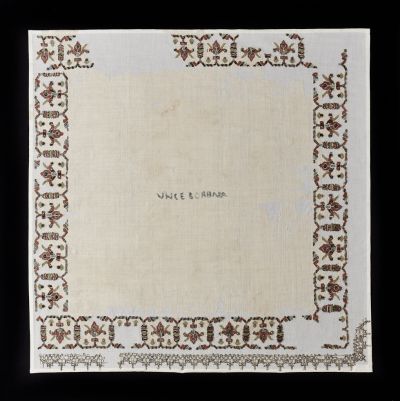
Kerchief
| Accession Nr.: | 19474 |
|---|---|
| Date of production: |
1575-1600
|
| Place of production: | Hungary |
| Materials: | canvas; gold coloured metal yarn; silk yarn; skófium |
|---|---|
| Techniques: | bobbin lace trimming; Italian cross stich; two-sided satin stitch |
| Dimensions: |
length: 68 cm
width: 65 cm
|
As with other Italian embroideries the decoration runs along the sides. There are panels of large-leaved foliage with apposing pomegranates. The gold braided lace on the edge has only partly survived on two sides. In the middle is a rough inscription, VINCE BORBALA, of later origin.
The running foliage motifs twined together can be found on most Western European embroideries the technique is characteristic of Italian linen embroidery. However, this piece is thought to be Hungarian. The 16th century embroideries survived only in a small number, and were mainly discovered through excavation. They prove that Hungary had already developed an individual type of needlework by that time. This piece shows the influence of both Western European and Oriental models the first mainly in the motifs, the latter in the colouring. In this case it is the colouring that indicates Hungarian origin.
Literature
- László Emőke: Magyar reneszánsz és barokk hímzések. Vászonalapú úrihímzések. Iparművészeti Múzeum, Budapest, 2001. - Nr. 1.
- Szerk.: Péter Márta: Reneszánsz és manierizmus. Az európai iparművészet korszakai. Iparművészeti Múzeum, Budapest, 1988. - Nr. 386. (téves ltsz.mal)
- Az 1896-iki Ezredéves Országos Kiállítás. A Történelmi főcsoport hivatalos katalógusa. Kosmos Műintézet, Budapest, 1896. - Nr. 2252.





